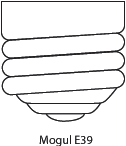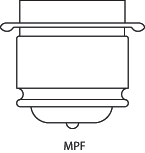There are two main types of light bulb bases: screw bases and pin bases. Each works in a different way to connect the light bulb to the electrical voltage in order to light the bulb. In this article, we will discuss screw bases.
Screw bases are the most common light bulb base. In an incandescent or halogen screw base light bulb, two contact wires connect the filament to the base of the light bulb, where the electrical voltage connects to the light bulb. The contact wires are soldered to the base metal at two different points on the base in order to keep them affixed to the base metal. If the contact wires were not permanently affixed to the base metal, electrical current would not be able to continuously flow through the wires to energize the filament into producing light. One of the contact wires is soldered on the side of the base, and the other is soldered at the bottom. Therefore, the light bulb makes electrical contact at two points on the base.

Screw bases come in several sizes, and they are referred to by both a descriptive name and size. Unlike the light bulb shapes, the number in the light bulb base measures the light bulb base diameter in millimeters. The candelabra E12 has a diameter of 12 millimeters. The “E” in the light bulb size refers to Edison, the inventor of the screw base light bulb, and screw base light bulbs are sometimes called “



The mogul pre-focused (MPF) base is similar to the screw base in that it connects the filament to the base with two soldered contact wires; however, MPF bases do not screw into the socket. Rather, the base metal has a smooth edge, and the base is pushed into the socket and then turned to lock it into place. The light bulb base and socket are manufactured in a way that predetermines the light bulb’s position in the socket. No matter how the end user places the light bulb base into the socket, it will always turn and lock into the same position every time, creating a fail-safe for the light bulb’s operation. Light bulbs with special coatings designed to focus light downward may use this type of base so that the light bulb will always be installed in the correct position to distribute and focus light properly.


The wedge base is found in incandescent T3.25 light bulbs. Wedge bases do not have any base metal or solder. Rather, they are made by tapering the glass of the bulb in a manner that seals the light bulb. Two wires at the base of the glass act as the electrical voltage contact points for the wedge base.





